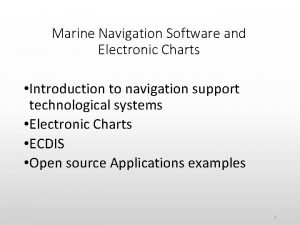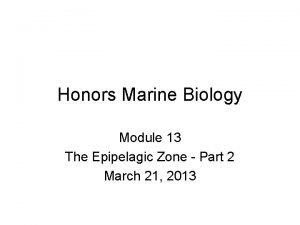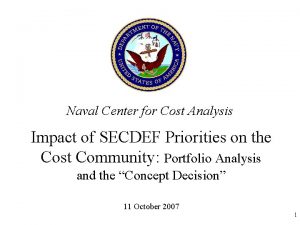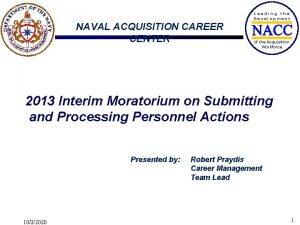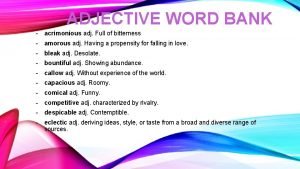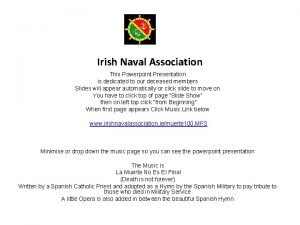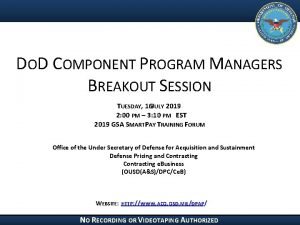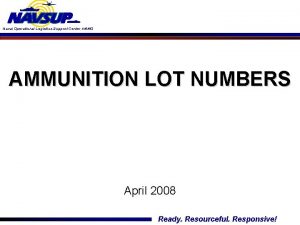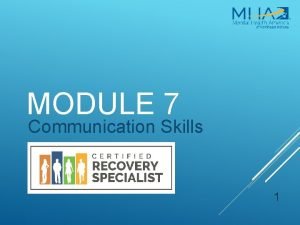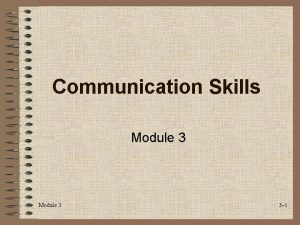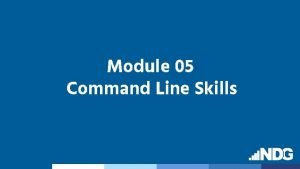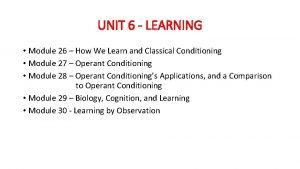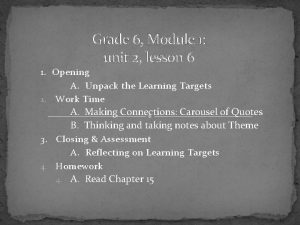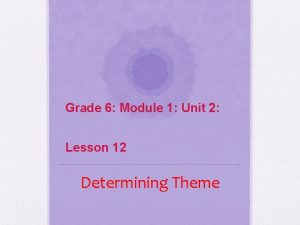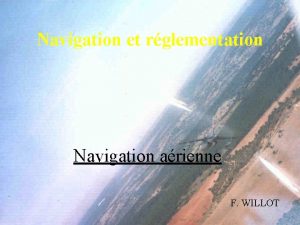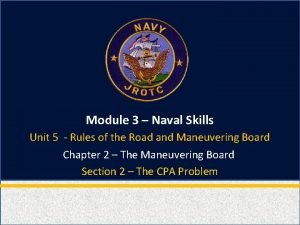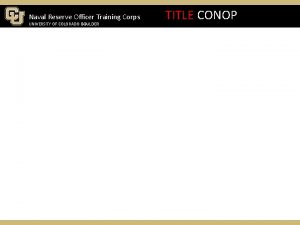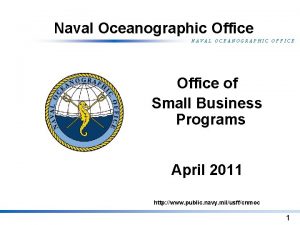Module 3 Naval Skills Unit 4 Marine Navigation























































- Slides: 55

Module 3 – Naval Skills Unit 4 - Marine Navigation Chapter 3 – Time and Navigation Section 2 – Kinds of Time

What You Will Learn To Do Demonstrate a basic understanding of navigation and the significant instruments used in this science

Objectives 1. Describe the various kinds of time 2. Describe the aspects of the date/time group

Key Terms CPS Key Term Questions 1 - 13

Key Terms Solar time ‑ Time based on the apparent motion of the Sun around the Earth Mean time ‑ Average solar time, based on the Sun’s apparent journey around the Earth (360°) in exactly 24 hours Revolution (of Earth) ‑ Path the Earth takes around the Sun

Key Terms Local mean time ‑ The time at your location based on the mean position of the Sun Mean Sun ‑ A hypothetical sun moving at a constant rate equal to the mean speed of the real sun making its annual circuit Universal An international time scale based coordinated time on the frequency of vibrations of (UTC) ‑ the radioactive cesium atom

Key Terms Almanac ‑ An annual publication with a calendar indicating the times of sunrises and sunsets, phases of the moon, tides, and other astronomical statistical information and related topics Equation of time ‑ The difference between apparent time and the mean time

Key Terms Standard time ‑ A 15°-wide sector or zone of the Earth in which the same time is kept by all it; uses as a basis the relationship of the mean Sun with the central meridian of the zone Zone time ‑ Time reckoned according to the relationship of the mean Sun with the central meridian of each 15°‑wide time zone

Key Terms Zone description (ZD) ‑ The difference between the time in a zone and GMT Daylight savings time ‑ Time change to gain an extra period of evening daylight; not used in navigation Date/time group (DTG) ‑ A number assigned to a communication that indicates the date and time.

Opening Question In what ways is timekeeping in the Navy different from timekeeping in civilian life? (Use CPS “Pick a Student” for this question. )

Warm Up Questions CPS Lesson Questions 1 - 2

Kinds of Time The Sun is the most convenient reference for reckoning time.

Kinds of Time Solar time is time based on the apparent motion of the Sun around the Earth. Apparent time is time based on the apparent position of the Sun from your position. Apparent time • Mean time • Atomic/UTC time • Zone time • Daylight savings • Zone time/GMT

Kinds of Time If the Sun is directly over the meridian we are on, we say that it is noon, local apparent time. When it is directly over the meridian 180° away from yours, it is midnight, local apparent time. Apparent time • Mean time • Atomic/UTC time • Zone time • Daylight savings • Zone time/GMT

Kinds of Time If the Earth stood still in space, and the Sun orbited in a circle around it, all days reckoned by apparent time would be exactly the same length. Hypothetical perfect orbit of a 24 -hour/360° circuit. Apparent time • Mean time • Atomic/UTC time • Zone time • Daylight savings • Zone time/GMT

Kinds of Time The Earth’s axis is inclined with respect to the plane of its orbit around the Sun, and the Earth’s speed along its elliptical orbit varies. Apparent time • Mean time • Atomic/UTC time • Zone time • Daylight savings • Zone time/GMT

Kinds of Time Therefore, the length of a solar day varies according to the position of the Earth in its orbit. Apparent time • Mean time • Atomic/UTC time • Zone time • Daylight savings • Zone time/GMT

Kinds of Time It would be confusing if some days had more hours and others fewer because of the Earth’s revolution, so an average, or mean solar time, is used. • Apparent time Mean time • Atomic/UTC time • Zone time • Daylight savings • Zone time/GMT

Kinds of Time Mean solar time is calculated from the motion around the Earth of an imaginary Sun, which always makes the 360°-circuit in exactly 24 hours. Hypothetical perfect orbit of a 24 -hour/360° circuit. • Apparent time Mean time • Atomic/UTC time • Zone time • Daylight savings • Zone time/GMT

Kinds of Time Local mean time (LMT) is the time at your location based on the mean position of the Sun – that is, at 1200 LMT, the mean Sun is over your meridian, not the actual Sun. Example month Mean sun difference November Actual sun ahead 16 1/2 minutes February Actual sun behind 14 minutes • Apparent time Mean time • Atomic/UTC time • Zone time • Daylight savings • Zone time/GMT

Kinds of Time The equation of time is tabulated in publications called nautical almanacs, and must be taken into account for certain tasks in celestial navigation at sea. • Apparent time Mean time • Atomic/UTC time • Zone time • Daylight savings • Zone time/GMT

Check On Learning Questions CPS Lesson Questions 3 - 4

Kinds of Time There is a modern base for time that is more accurate than calculations based on the relationship of Earth and the Sun. It is atomic time or universal coordinated time (UTC). • Apparent time • Mean time Atomic/UTC time • Zone time • Daylight savings • Zone time/GMT

Kinds of Time UTC is an internationally agreed-upon time scale based on the frequency of vibrations of the radioactive cesium atom. Cesium is a fairly common element and readily available for atomic clocks everywhere. • Apparent time • Mean time Atomic/UTC time • Zone time • Daylight savings • Zone time/GMT

Kinds of Time UTC and GMT can differ at certain times by as much as 9/10 of a second. The difference is usually smaller, and can be disregarded for most navigational purposes. GMT Based on the relative motion of Earth and the Sun UTC Based on the unchanging cesium frequency • Apparent time • Mean time Atomic/UTC time • Zone time • Daylight savings • Zone time/GMT

Kinds of Time Greenwich mean time (GMT) is time based on the relationship of the mean Sun to the prime meridian. Greenwich • Apparent time • Mean time Atomic/UTC time • Zone time • Daylight savings • Zone time/GMT

Kinds of Time Zone time (ZT) = standard time. Standard time zones were established to eliminate short-distance differences if local mean time (LMT) were strictly observed. Observing LMT, a person on the east end of NYC’s 42 nd Street would be about 9 seconds off from a person on the west end. • Apparent time • Mean time • Atomic/UTC time Zone time • Daylight savings • Zone time/GMT

Kinds of Time Since one hour is 15°, each time zone is based on a division of the globe into 24 zones of 15° each. A standard time-zone system is fixed by international agreement and by law in each country. • Apparent time • Mean time • Atomic/UTC time Zone time • Daylight savings • Zone time/GMT

Kinds of Time The zones begin at 0° with the Greenwich meridian. Each meridian is at the center of its time zone, and extends 7 1/2° (half of 15°) on either side of the meridian, but may vary to make life easier for people living there. Prime meridian Greenwich • Apparent time • Mean time • Atomic/UTC time Zone time • Daylight savings • Zone time/GMT

Kinds of Time Each time zone is identified by a letter and by a negative or positive number. The number is called the zone description (ZD), and the letter is called the suffix. -7 -8 -9 -10 -11 -12 East from the prime meridian West of 0°, West of ZDs +1 to +12 -1 -2 -3 -4 -5 East from the prime meridian • Apparent time • Mean time • Atomic/UTC time Zone time • Daylight savings • Zone time/GMT

Kinds of Time The international date line is at the 180 th meridian. The time of day is the same on both sides of the line. However, it is one day later on the west side of the line. • Apparent time • Mean time • Atomic/UTC time Zone time • Daylight savings • Zone time/GMT

Kinds of Time zone perimeters fall between longitude lines. • Apparent time • Mean time • Atomic/UTC time Zone time • Daylight savings • Zone time/GMT

Kinds of Time The result is that the zone descriptions -12 and +12 each extend 7 1/2° (half of 15°) over a longitudinal line, to the international date line. • Apparent time • Mean time • Atomic/UTC time Zone time • Daylight savings • Zone time/GMT

Kinds of Time The continental United States has four standard time zones. • Apparent time • Mean time • Atomic/UTC time Zone time • Daylight savings • Zone time/GMT

Kinds of Time Eastern standard time (EST) is identified as +5 Romeo (R). • Apparent time • Mean time • Atomic/UTC time Zone time • Daylight savings • Zone time/GMT

Kinds of Time Central standard time (CST) is identified as +6 Sierra (S). • Apparent time • Mean time • Atomic/UTC time Zone time • Daylight savings • Zone time/GMT

Kinds of Time Mountain standard time (MST) is identified as +7 Tango (T). • Apparent time • Mean time • Atomic/UTC time Zone time • Daylight savings • Zone time/GMT

Kinds of Time Pacific standard time (PST) is identified as +8 Uniform (U). • Apparent time • Mean time • Atomic/UTC time Zone time • Daylight savings • Zone time/GMT

Kinds of Time Alaska is identified as +9 Victor (V). Hawaii is identified as +10 Whiskey (W). • Apparent time • Mean time • Atomic/UTC time Zone time • Daylight savings • Zone time/GMT

Kinds of Time Daylight savings time (DST) is not used in navigation. • Apparent time • Mean time • Atomic/UTC time • Zone time Daylight savings • Zone time/GMT

Kinds of Time Daylight savings time is zone time set ahead one hour. The practice varies, but when used, it extends summer evening daylight. For the northern hemisphere: • “Spring” forward an hour to begin DST • “Fall” back an hour to end DST In the southern hemisphere, summer is December to March, so DST, if used, begins in the latter part of the year. • Apparent time • Mean time • Atomic/UTC time • Zone time Daylight savings • Zone time/GMT

Check On Learning Questions CPS Lesson Questions 5 - 6

Kinds of Time The Greenwich Mean Time is identified as 0 Zulu (Z). 0° Greenwich meridian • Apparent time • Mean time • Atomic/UTC time • Zone time • Daylight savings Zone time/GMT

Kinds of Time Most information in navigational tables and naval communications uses GMT, so you must know how to convert the time in any zone to GMT. • Apparent time • Mean time • Atomic/UTC time • Zone time • Daylight savings Zone time/GMT

Kinds of Time Each time zone represents one hour, beginning at Greenwich. The zone description positive numbers run west and negatives east. -7 -8 -9 -10 -11 -12 East from the prime meridian West of 0°, West of ZDs +1 to +12 -1 -2 -3 -4 -5 East from the prime meridian • Apparent time • Mean time • Atomic/UTC time • Zone time • Daylight savings Zone time/GMT

Kinds of Time Convert from to GMT Any time zone GMT Algebraic expression Example ZT = GMT - ZD From GMT to zone Echo (E) 0600 Z - (-5 h) = 1100 E GMT = ZT + ZD From zone Sierra (S) to GMT 0600 S + (+6) = 1200 Z Y X W V U T S R Q P O N +12+11+10 +9 +8 +7 +6 +5 +4 +3 +2 +1 Z A 0 -1 B C D E F G H I K L M -2 -3 -4 -5 -6 -7 -8 -9 -10 -11 -12

Kinds of Time Note that in algebra, two minuses make a plus. Converting from GMT, subtraction is used. If the ZD is negative, the ZD is added to the GMT time. Convert from to GMT 0600 Z Golf time zone Algebraic expression Example ZT = GMT - ZD From GMT to zone Golf (G) 0600 Z - (-7 h) = 1300 G

Kinds of Time The zone time alphabetical suffixes are: Westerly N November O Oscar P Papa Q Quebec R Romeo S Sierra T Tango U Uniform V Victor W Whiskey X X-ray Y Yankee Greenwich Z Zulu Easterly A Alpha B Bravo C Charlie D Delta E Echo F Foxtrot G Golf H Hotel I India K Kilo L Lima M Mike • Apparent time • Mean time • Atomic/UTC time • Zone time • Daylight savings Zone time/GMT

Kinds of Time In writing naval time, it is generally required to place a time zone’s letter after the numbers. Example: 11: 00 a. m. in Norfolk would be written 1100 R • Apparent time • Mean time • Atomic/UTC time • Zone time • Daylight savings Zone time/GMT

Kinds of Time Another aspect of naval time, called the date/time group, involves the date, the month, and the year in naval communications. With a constant (24/7) flow of communications, there must be some way to identify exactly when a message was originated or received.

Kinds of Time The date/time group (DTG): • Is placed in the message heading • Identifies when a communication originated • Is used for filing

Kinds of Time The DTG consists of six digits. The first two digits represent the date, the second two digits represent the hour, and the third two digits represent the minutes. Example: 151635 Z APR 10 means the 15 th day of April plus the time in Greenwich mean time (GMT).

Review Question Describe the components of a date/time group number. (Use CPS “Pick a Student” for this question. )

Closing Questions CPS Lesson Questions 7 - 8

Questions?
 Marine chart software
Marine chart software Marine biology module 3 study guide
Marine biology module 3 study guide What is the importance of dom in the epipelagic?
What is the importance of dom in the epipelagic? C device module module 1
C device module module 1 Mexico wwi
Mexico wwi Feiws
Feiws Fantail of ship
Fantail of ship Naval center for cost analysis
Naval center for cost analysis Monarc 155mm
Monarc 155mm Naval acquisition career center
Naval acquisition career center Naval station puget sound
Naval station puget sound Barcos combate naval de iquique
Barcos combate naval de iquique Guia combate naval de iquique
Guia combate naval de iquique Poesia arturo prat chacon para niños
Poesia arturo prat chacon para niños Instituto universitario naval
Instituto universitario naval Alyson chwatek
Alyson chwatek Naval service training command
Naval service training command Dmsms navy
Dmsms navy Dra norma naval tucumán
Dra norma naval tucumán Acrimonious origin
Acrimonious origin Naval architecture terms
Naval architecture terms Russia naval base
Russia naval base Feiws
Feiws Naval surface warfare center
Naval surface warfare center Cpars narrative examples
Cpars narrative examples Secnavinst 5216
Secnavinst 5216 Slua muiri
Slua muiri Naval surface warfare center
Naval surface warfare center Naval manak
Naval manak Royal norwegian naval academy
Royal norwegian naval academy Navy customs and traditions
Navy customs and traditions Ammunition lot number
Ammunition lot number Naval coating
Naval coating Naval ordnance safety and security activity
Naval ordnance safety and security activity James fraser naval aviator
James fraser naval aviator James fraser naval aviator
James fraser naval aviator This module will focus on communication skills at work
This module will focus on communication skills at work Basic employability skills nccer
Basic employability skills nccer Module 00108 exam basic employability skills
Module 00108 exam basic employability skills Word processing packages
Word processing packages Module 9 computer concepts
Module 9 computer concepts Module 11 computer concepts exam
Module 11 computer concepts exam Module 3 communication/interpersonal skills
Module 3 communication/interpersonal skills 00107-15 basic communication skills
00107-15 basic communication skills Module 7 basic communication skills
Module 7 basic communication skills Module 8: basic employability skills
Module 8: basic employability skills What is supportive communication
What is supportive communication Module 5 - command line skills
Module 5 - command line skills Unit 10, unit 10 review tests, unit 10 general test
Unit 10, unit 10 review tests, unit 10 general test Inter and intra personal skills
Inter and intra personal skills Soft skill vs hard skill
Soft skill vs hard skill Skills passport
Skills passport How we learn and classical conditioning module 26
How we learn and classical conditioning module 26 Grade 6 module
Grade 6 module Unit error
Unit error Grade 6 module 1: unit 2 answer key
Grade 6 module 1: unit 2 answer key
